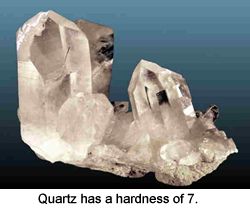BACKGROUND:
The obvious descriptive characteristics of a mineral
such as size, shape, and color are not the only features that can identify
that mineral. Geologists recognize a number of useful key characteristics
for mineral identification. These include:
- CRYSTAL FORM - The natural growth (shape) of a
mineral.
- FRACTURE AND CLEAVAGE -The way a mineral breaks.
Fracture is irregular breakage. For example, quartz has a conchoidal
fracture; it breaks along hollowed and rounded, uneven surfaces.
Cleavage is a regular breakage that follows the atomic structure of a
mineral. Cleavage results in smooth, planar surfaces. Different minerals
may have one, two, three, four, or six cleavages.
- HARDNESS - The mineral’s resistance to
scratching. It is controlled by the strength of atomic bonds within the
mineral. Mineral hardness is rated from 1 (soft) to 10 (hard) on the
Mohs hardness scale.
- SPECIFIC GRAVITY - The density of a mineral
relative to water.
- STREAK - The color of a powdered mineral sample.
- LUSTER - The way that a mineral reflects light.
There are two types of luster. Metallic minerals look like shiny or
rusted metal. Nonmetallic elements reflect light like glass or pearls or
glue.
 TASTE
- Certain minerals like halite (salty) and sulfur (bitter) have
characteristic "flavors." TASTE
- Certain minerals like halite (salty) and sulfur (bitter) have
characteristic "flavors."- MAGNETISM - The attraction of a mineral to a
magnet.
- REACTION TO ACID - The mineral reacts by
"fizzing" with dilute HCl reacts with carbonate minerals.
This lab will deal with "hardness" which is
one of the easiest characteristics to test. Hardness helps geologists
determine the identity of some minerals when they are doing field work. For
instance, if a steel knife cannot scratch a white or clear mineral, it is
likely quartz. Hardness also can tell us something about the composition of
minerals (how tightly the elements are bonded together). Formally, the
hardness of a mineral is ranked by Mohs Hardness Scale (named after Austrian
mineralogist Friedrich Mohs), which lists 10 reference minerals that are
arranged in increasing order of hardness. Note that this is a relative
hardness scale; diamond is actually over four hundred times harder than
talc.
Mohs Hardness Scale
1 = talc
2 = gypsum
3 = calcite
4 = fluorite
5 = apatite |
6 = microcline (feldspar)
7 = quartz
8 = topaz
9 = corundum
10 = diamond |
PROCEDURE:
- Before lab, set up mineral specimen collections for each student
group. You will need samples of gypsum, olivine, mica, fluorite, calcite,
apatite, hematite, talc, feldspar, and quartz. Use the Rock Cycle -
Minerals (5A) samples or samples of your own.
Do not include rocks with this lab. Since most rocks are composed of a
variety of minerals, they cannot be classified on the Mohs scale. If you
have not tested mineral hardness using a penny or a nail, you may wish
to experiment before the lab starts. This will also help you guide the
students to use the right amount of strength and pressure when
scratching the minerals. You should limit it to one scratch or the
specimens will not last long.
- Explain the lab procedure from the student workbook. Let the students
be geologists (or mineralogists) and create their own hardness scales
using fingernails, pennies, and steel nails. You might want to
demonstrate how hard it is to scratch the minerals. Instruct students
to "test" the mineral specimens. Sometimes samples can vary, so
you should "discover" a key for the specific samples in
advance.
- Tally
the students' results on the board and determine a hardness scale for
the whole class. Emphasize that their results may differ because some
people scratch harder than others and many minerals are "in
between" soft and hard.
- GENERAL ANSWER using Rock Cycle - Minerals (5A): softness to hardest:
talc, gypsum, mica, calcite, fluorite, apatite, hematite, feldspar,
olivine, quartz
|